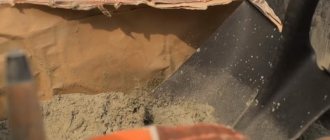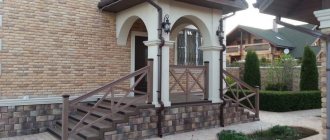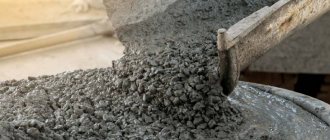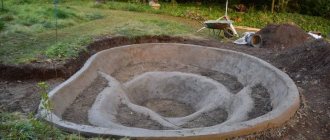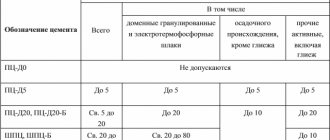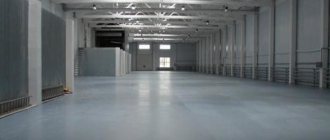Grade M400 (B30) is an industrial type of concrete that is rarely seen on private construction sites. Professionals value it for its resistance to sub-zero temperatures and moisture. The characteristics of the material fully satisfy all the requirements for industrial facilities.
The strength, frost resistance and other indicators of this material are significantly higher than those necessary for the construction of a one-story house or for landscaping. In addition, M400 concrete is expensive. Therefore, it makes no sense to buy it for private construction. It can be replaced with more affordable brands without compromising quality.
In this article you will learn what concrete M400 (B30) is, what it is made from, and in what proportions it is mixed. We will tell you in detail for what purposes and works this brand is purchased. At the end we will also mention all the advantages and disadvantages of this material.
Technical characteristics of concrete M400
The main characteristics of the material are regulated by GOST 31108-2003 “General construction cements”, GOST 7473-2010 “Concrete mixtures” and a number of other regulatory documents.
Important technical parameters that the concrete solution must meet:
- Mobility (workability) - P4. Concrete can be poured into reinforced structures without additional compaction, which is effective when constructing foundations and columns. If necessary, by introducing additives and changing proportions, it is possible to obtain M400 concrete with mobility P3 or P5.
- Water resistance - W6–W12. Finished structures made from this solution can withstand liquid pressure of 0.6-1.2 MPa. Concrete can be used for underwater structures - dams, swimming pools.
- Frost resistance - F100-F300. Concrete can withstand from 100 to 300 cycles of freezing and thawing (the exact figure depends on the type and number of special modifiers). Due to such high frost resistance, the solution is used for buildings in harsh climates.
- The density of M400 concrete is more than 2400 kg/m³, compressive strength is 400 kgf/cm². These indicators make the material very reliable, wear-resistant and durable.
Concrete M400 has excellent characteristics, therefore it is suitable for the construction of most buildings, structures and structures in everyday life and industry. It sets faster than other brands, and this property makes it possible to speed up construction work.
Important! After hardening, the solution turns into an indestructible monolith, which is practically unaffected by natural factors.
How to determine the quality of concrete
On your own - no way. No options. Neither by color, nor by smell, nor by consistency, not one, even the most professional customer, will be able to determine whether the supplier really brought him the exact brand of concrete he ordered. The solution is tested only after it has hardened.
The check is carried out using different methods:
- laboratory;
- professional (ultrasound, sclerometer);
- folk-approximate - determine the quality of concrete by color, smoothness, ringing when struck, etc. This is all about the same as determining the quality of sausage by color - an absolutely useless exercise.
That is why experienced specialists recommend ordering concrete from the manufacturer. Do you want - with delivery to the site, or do you want - without it. In this case, there are a couple of tips:
- don't go for cheap. If you win on price, you lose on quality;
- talk to the manufacturer’s manager - a self-respecting specialist will never offer you to buy the required volume “approximately” or “by eye”. A good seller will definitely ask: for what work concrete is needed, area to be poured, etc. Only after clarifying all the nuances will he calculate the exact volume of material.
The BAV Group company has been supplying GOST concrete to construction sites in Moscow and the Moscow region for 10 years. We value our excellent reputation, so our customers do not know what a poor-quality solution or rude service means. Don't believe me? Call and see for yourself!
Composition and proportions of components
The material contains standard ingredients: river or quarry sand, cement, gravel or crushed stone. The finished mixture is diluted with clean water without chemical impurities.
To improve technical parameters, plasticizers and other additives are also necessarily introduced into the composition. To make colored concrete, colors can be added to it.
Concrete M400 on crushed stone
When mixing the material with your own hands or in industry, use the following proportions:
- cement – 1 part;
- sand – 1.5 parts;
- crushed stone - 2.5 parts;
- water – 0.5 parts.
Advice! If a construction project requires a large amount of mortar, it would be more expedient to buy it ready-made at the factory and deliver it to the construction site by special transport.
Production technology
The production of mortar for any brand of concrete is identical. It is only important to comply with all technological conditions. Then you will get a high-quality solution of the required consistency, which will ensure the durability and strength of the structure being poured.
Even a small error in the production process can lead to a decrease in the quality properties of concrete.
The process of producing concrete for private and industrial construction is almost the same and includes a strict procedure:
- Preparation of the main components of the solution. Includes washing, cleaning and sifting of dry fillers - sand and crushed stone. The water is filtered to prevent the presence of various suspensions and particles in it. Portland cement is suitable only for recently produced cement, which has not yet had time to compact and form lumps.
- Mixing components. First, the dry fillers and Portland cement are mixed. Lastly, add water and mix until smooth.
In private construction, mixing can be done manually or in a small-volume concrete mixer. Concrete plants use concrete mixers (planetary, twin-roll, disc), which allow mixing huge volumes of mortar.
Uniform distribution of components in the solution guarantees the strength and durability of the structures being poured.
- Compliance with technological production conditions. Kneading should be done at a temperature of 20 ℃ and a humidity of 40-60%. It is important to maintain these indicators throughout the entire time – from mixing the components to delivering the concrete to the construction site. Otherwise, the mixture will separate and it will lose its properties.
Duration of mixing concrete grade M400 depending on the capacity of the container for mixing the solution:
- less than 750 l – 60 sec;
- 750-1500 l – 90 sec;
- more than 1500 l – 120 sec.
Concrete strength classes m400
The strength class of a mortar is understood as a numerical parameter that determines its compressive strength. It is calculated in megapascals and is designated by the letter “B”.
Concrete grade M400 corresponds to strength class 30 (B30). This means that concrete can withstand a pressure of 30 megapascals after complete hardening in at least 95% of cases. This figure is considered very high, so the material belongs to the structural group and is suitable for the construction of high-rise buildings.
Price
The high cost of concrete is explained by many advantages. Today it is approximately $60 per cubic meter. In terms of its efficiency, this building material falls into the middle category. It is sold in the form of a ready-made solution, the mobility of which reaches three to five points. The mixture is sold in most specialized stores for builders. The solution can be found at production points, at enterprises that produce products and structures made of cement.
Experts advise working with reliable suppliers of building materials, since it is visually difficult to determine the type of mixture. To obtain high-quality concrete, you need to strictly adhere to the technology and recommendations for adherence to the recipe and the ratio of components.
Application of M400 concrete
The material is used for the construction of objects, during the operation of which significant mechanical loads arise, which contribute to strong stress on the monolith. The following structures are built from M400 concrete:
- bridges on highways, railways;
- overpasses for transport and overpasses, viaducts;
- bank vaults, ammunition and weapons warehouses, military buildings;
- columns, lintels, beams;
- hydraulic structures - dams, dams, breakwaters, swimming pools, hydroelectric power stations;
- monolithic high-rise buildings;
- collectors for communications;
- any objects requiring high security;
- stairs and flights of stairs;
- buildings in the energy, engineering, ore mining sectors;
- sewer tunnels;
- foundations of multi-story buildings;
- metro facilities.
Concrete is suitable for pouring durable reinforced concrete structures that will endure the most severe loads. In this case, granite filler is introduced into its composition instead of crushed stone.
Preparation of concrete
In order for a solution made at home to fully meet the requirements, you will have to obtain only the highest quality components for mixing it. It is also important to accurately observe the proportions and manufacturing technology of M400 concrete.
The sand must be clean, without impurities of soil, clay, lime, which increase the viscosity and interfere with the adhesion of the solution. In addition, if dirty sand is used, the strength of the concrete will decrease.
Advice! The ideal option is not to collect sand yourself, but to buy it in a hardware store in an already purified form.
As a last resort, quarry or river sand will do, but only well washed and dried. Before mixing concrete, wet sand is dried or the amount of water in the solution is reduced. The liquid should also be clean, completely free of chemical impurities and slightly warm (not hot).
The crushed stone for concrete is not large, but not small either, approximately within the range of 5-20 mm (size of individual elements). It is better to take only high-quality types of crushed stone with a strength index of M1100 or more, which are produced by crushing the hardest rocks.
The requirements for cement are the most stringent:
- grade - no lower than ready-made concrete (otherwise the solution will have a low specific gravity);
- fine-grained variety;
- absence of excessive moisture, lumps;
- storage - only in the right conditions and no more than 3 months from the date of production.
After selecting the components, they begin to weigh them. First, combine cement and sand, mix the mass thoroughly in a concrete mixer until it becomes homogeneous.
Afterwards, a liquid with dissolved plasticizers is introduced, which was strictly adjusted in volume in advance. The strength and frost resistance of concrete depend on strict adherence to water standards. The last thing to do is add crushed stone and mix the solution again, which should resemble thick sour cream in texture.
When ready, the concrete is transported to the site and pouring begins. To prevent the material from hardening too quickly, or from slowing down the hardening process, it is important to work at positive temperatures, but not in extreme heat.
Advice! In addition to independently selecting the components and calculating the proportions, you can go the other way - buy ready-made dry mixture in bags and dilute it with water.
General concept
The density of concrete B30 or another analogue physically means the weight of a cubic meter of a particular sample. In relation to cement mortars, a complex of points is additionally considered. These include the following:
- air content;
- proportions of mineral filler;
- characteristics of the added gravel;
- hardness of the monolith after drying;
- strength indicators for tension and compression.
It turns out that with a minimum content of air pores, maximum homogeneity of the artificial stone is observed. This also “speaks” that this sample has high tensile strength. And when using river sand and, for example, granite gravel, the composition will meet higher requirements than those made from rounded grains with crushed limestone. Rough edges promote the formation of stronger bonds between individual granules. Everything is relevant, among other things, only if the proportions of the components and the shelf life of the cement binder are observed. Excess water and damaged cement reduce any results to “failures.”
Source lalafo.com
Example of calculation in buckets per 1 cubic meter
At home, it is most convenient to measure components using a standard 10-liter bucket, which any builder has. Each liter of volume in a bucket is equal to 1 dm³, that is, the entire volume will be 0.01 m³ (10 dm³).
To obtain concrete, in addition to 300 liters (30 buckets) of cement, the following components are taken:
- Sand with a density of 1600 kg/m³. There are 1.6 kg of sand per liter. For a norm of 630 kg, the volume will be 394 kg, the number of buckets will be 39.4.
- Crushed stone with a density of 1400 kg/m³. A liter contains 1.4 kg. For a norm of 1050 kg, the volume is 750 liters, that is, 75 buckets.
- Water. In total you need 210 liters of water, or 21 buckets.
Knowledge of the specified standards and proportions will allow you to determine the number of components that will be required to fill the structure, as well as the approximate costs.
Example of calculation in a concrete mixer
The standard tank volume of a concrete mixer is 140 liters. Usually it is loaded no more than 2/3 full to allow the components to mix better.
Thus, the loading rate will be 140x2/3 = 93 liters. When combining the coefficients in proportion, the figure is 5.5 (1 part cement + 1.5 parts sand + 2.5 parts crushed stone + 0.5 parts water). By multiplying by 10 liters (the volume of the bucket), 55 liters are obtained, and when dividing 93 l/55 l, the number of loads is calculated - 1.69 pieces.
When multiplied by 1.69 by the proportions, the following standards are obtained for one load into a concrete mixer:
- cement – 16.9 l;
- sand – 25.3 l;
- crushed stone - 42.3 l;
- water – 8.5 l.
